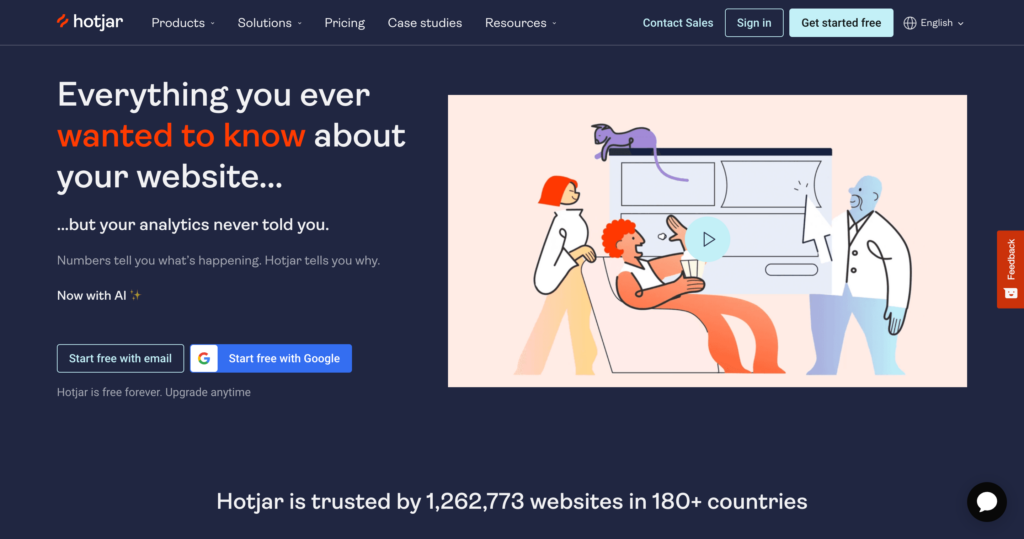Your cart is currently empty!
Conversion Rate Optimization (CRO) is a systematic process that focuses on increasing the percentage of website visitors who take a desired action, such as signing up for a newsletter, buying a product, or filling out a contact form.
CRO is about understanding your audience and tailoring your website’s experience to meet their needs. This guide will explain why it matters, popular tools, how to get started, and further best practices.
What is CRO?
Conversion Rate Optimization, commonly abbreviated as CRO, is a strategic process aimed at increasing the proportion of website visitors who take a specific action. This action could range from making a purchase to signing up for a newsletter, downloading a file, or engaging with certain content on your site.
The fundamental essence of CRO is enhancing the user experience on a website so that more visitors complete the intended actions. It revolves around the understanding that not all visitors to your website will automatically become customers or subscribers.
By making targeted and data-informed changes to website content, design, and user pathways, CRO seeks to make it easier and more compelling for visitors to take those steps toward conversion.
Why CRO Matters
It can be a pivotal strategy in digital marketing. Here’s a snapshot of why:
- Maximizing Return on Investment (ROI): CRO ensures you get the most out of every marketing dollar by improving the efficiency of your digital assets, leading to better results without necessarily increasing your marketing spend.
- Enhancing User Experience (UX): CRO focuses on understanding and catering to user behaviors, preferences, and barriers, which inadvertently leads to a more satisfying and loyal user experience.
- Increasing Competitive Advantage: A site optimized for conversions stands out, being more intuitive, trustworthy, and user-friendly, giving you an edge over competitors.
- Scalable and Sustainable Growth: CRO ensures you’re not just getting traffic, but value from that traffic. This helps you scale and streamline efforts.
- Building Trust and Credibility: A well-optimized site communicates professionalism and credibility, fostering trust and increasing the likelihood of conversions.
Even though you may be making small adjustments, those can lead to surprising and significant results that will help your business grow.
Popular CRO Tools
Having the right tools in your belt is crucial for effectively implementing and monitoring a CRO strategy. These tools help in data collection, analysis, testing, and implementation. Let’s delve into some of the industry favorites:
Google Analytics

Google Analytics is a free tool that provides comprehensive data on your website visitors, their behaviors, and conversion patterns. You can understand where your traffic comes from, the behavior of users once they land on your website, and where they drop off in the conversion process.
Hotjar

Hotjar offers heatmaps, session recordings, and surveys, giving you visual insights into how users interact with your site. You can identify trouble areas, such as pages with high exit rates or elements that users struggle to interact with.
Optimizely

Optimizely allows for A/B testing, multivariate testing, and more. You can experiment with different website versions, compare results, and determine which changes lead to the best conversion rates.
Unbounce

Primarily a landing page builder, Unbounce also offers A/B testing features. This ensures that not only can you create visually appealing landing pages, but you can also test various elements to find the most effective design for conversions.
VWO (Visual Website Optimizer)

Another A/B testing tool, VWO also offers split URL testing and multivariate testing. Its interface is user-friendly, making it easier to set up and run tests, even if you’re new to CRO.
These tools can provide crucial insights, run effective tests, and help you make informed decisions to optimize your website’s conversion rate. The right tool for you will depend on your needs and the tool’s offerings, but these are a great place to start.
What to Test and Optimize
Let’s cover some of the top things to test. We’ll go into each element, offer optimization suggestions, and try to set expectations for results.
Call-to-Action (CTA) Buttons
The CTA button is the primary prompt on a page that encourages users to take action, whether signing up, purchasing, or any other desired outcome. It’s essential as it directly impacts conversions.
Test Suggestions
- Color and Size: Try out vibrant colors or larger sizes that make the CTA stand out.
- Text and Language: Switch up words; instead of “Submit”, consider “Get Started” or “Download Now”.
- Placement: Place the CTA both above and below the fold or next to critical information.
Tweaking the CTA can lead to higher visibility and urge the user to click. By optimizing it, you may observe higher engagement rates and improved conversions.
Landing Page Headlines
Headlines are the first text users typically read. A compelling headline can retain users and convey the primary message of the page.
Test Suggestions
- Clarity: Use clear and direct messages that resonate with the product or service.
- Brevity: Short, impactful headlines can often be more effective.
- Visual Appeal: Test with different fonts, colors, or styles.
The headline can set the tone for user engagement. A well-optimized headline can retain users longer and make them more receptive to your content, leading to increased conversions.
Page Layout and Design
The design and structure of your page play a vital role in user experience, determining how users interact with the content and how smoothly they can navigate.
Test Suggestions
- Content Arrangement: Prioritize information and vary CTA placements.
- Visual Design: Experiment with color schemes or graphics.
- User Experience (UX): Test mobile-friendly designs and other layout variations.
A layout optimized for your audience can enhance readability and user flow, reducing bounce rates and increasing time spent on site.
Images and Videos
Visual content can make concepts tangible, enhance engagement, and reduce the need for lengthy textual explanations.
Test Suggestions
- Visual Content: Rotate through different images or videos representing products or concepts.
- Placement: Shift visual elements around the page.
- Size and Format: Play with various sizes and image/video formats.
Optimized visuals can evoke emotions, clarify complex concepts, and potentially boost conversions. Faster images can also improve site performance and SEO.
Forms and Input Fields
Forms are often the gateway to conversions, gathering user information for various purposes, from newsletter signups to purchases.
Test Suggestions
- Field Number and Type: Minimize the number of fields or test different field types.
- Labels and Instructions: Use clearer label text or user-friendly instructions.
- Validation and Errors: Provide real-time feedback.
Streamlined forms can reduce user friction, leading to more form completions and thus, higher conversions.
Product Descriptions
Product descriptions detail what you’re selling, and they can bridge the gap between interest and purchase. A good product description helps users understand the value and benefits of what’s on offer.
Test Suggestions
- Length and Detail: Try shorter, punchy descriptions versus detailed explanations.
- Style and Tone: Compare a professional tone against a casual or playful one.
- Use of Bullet Points: Test descriptions with bullet points for easy scanning.
The right product description can make a user feel they need your product. Optimizing descriptions can lead to better product understanding and increased sales.
Trust Signals
Trust signals, such as testimonials, reviews, and security badges, provide assurance to users, building credibility and reducing purchase anxiety.
Test Suggestions
- Placement: Try placing trust signals near CTAs or the product description.
- Types of Signals: Experiment with customer reviews, expert endorsements, or industry certifications.
- Visual Representation: Test the impact of real photos in testimonials versus generic images or avatars.
Enhancing trust can decrease user reservations about buying a product or providing personal information. Increased trust often translates to higher conversion rates.
Navigation and User Flow
Navigation guides users through your website. A clear, intuitive navigation system ensures users can easily find what they’re looking for, improving their overall experience.
Test Suggestions
- Menu Structure: Experiment with horizontal versus vertical menus.
- Breadcrumb Navigation: Test the inclusion of breadcrumb trails on deeper pages.
- Interactive Elements: Use dropdowns, mega menus, or flyouts for dense information.
Clear navigation reduces user frustration, making them more likely to stay on your site longer and complete desired actions.
These are just some of the top candidates for what to test. Really, you should let your intuition and creativity guide you. If you think something could be better, or you’re curious about what making X change would do, plan a test.
CRO Best Practices
Effective CRO isn’t just about running tests and making changes. It’s about following a strategic approach and adhering to best practices. Here’s a deeper dive into some key techniques to ensure your efforts yield results:
- Understand Your Audience: Before diving into tests, invest time in understanding your target audience. Conduct surveys, interviews, and user testing sessions to learn about their needs, preferences, and pain points. The more you know about them, the better you can customize your site to cater to their needs.
- Start with a Clear Hypothesis: Every test should begin with a hypothesis based on data or user feedback. For instance, “Changing the call-to-action button color to blue will increase click-throughs by 10%”. This gives your tests direction and purpose.
- Prioritize Your Tests: Not all changes will have the same impact on conversions. Create a prioritization framework based on potential impact and effort required. For example, tweaking a headline on a high-traffic landing page might be more impactful than changing a minor element on a less-visited page.
- Test One Variable at a Time: For clear, actionable insights, change only one element per test. This ensures that you can attribute any difference in performance directly to that change. If you change multiple elements simultaneously, it’s hard to decipher which change led to the observed results.
- Run Tests for a Sufficient Duration: It’s essential to run tests long enough to obtain statistically significant results. Ending tests too early can lead to decisions based on incomplete data. A good rule of thumb is to wait until you have a large enough sample size and the results remain consistent over time.
- Analyze and Learn from Every Test: Whether a test is successful or not, there’s always something to learn. Analyze the results, understand user behavior, and document insights. This knowledge is invaluable for future CRO endeavors.
- Be Wary of Seasonal Variations: Traffic and user behavior can vary depending on the time of year, holidays, or even days of the week. Ensure you account for these variations when interpreting results to avoid making decisions based on skewed data.
- Keep User Experience in Mind: CRO is not just about increasing conversions but also ensuring a positive user experience. Avoid tactics that might boost conversions in the short term but could harm user trust or satisfaction in the long run.
By adhering to these best practices, you’ll be well on your way to crafting a CRO strategy that not only boosts conversions but also enhances the overall user experience. CRO is a continuous process; regular testing and refining are key to long-term success.
Bottom Line
Conversion Rate Optimization is not just about increasing numbers; it’s about understanding your users, their needs, and continuously refining their experience on your website. By focusing on CRO, you can maximize the value of every visitor, leading to better user experience, higher ROI, and increased revenue. Always keep testing, learning, and iterating, ensuring your site meets your audience’s evolving needs. ?
Topics






